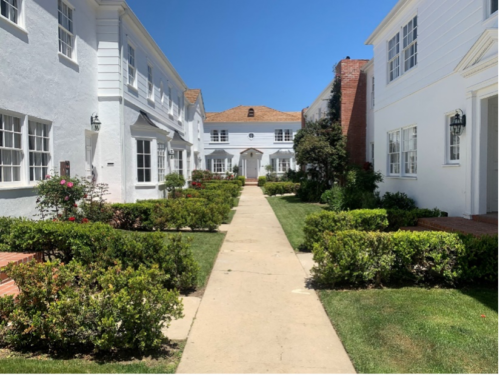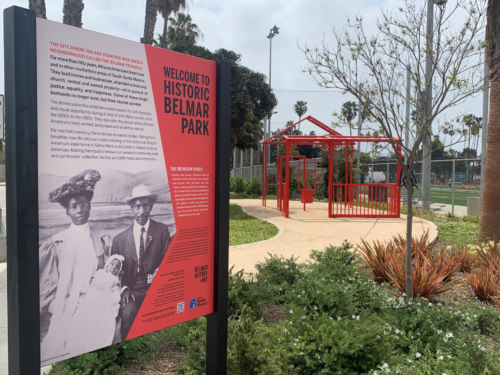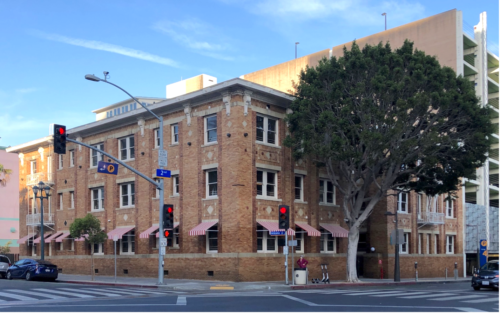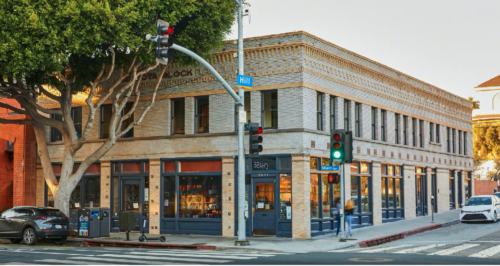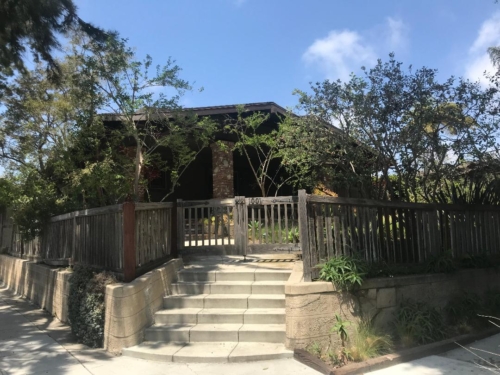News
The Santa Monica Conservancy Announces 2021 Preservation Awards
The Santa Monica Conservancy recognized six exemplary contributors to the preservation of Santa Monica’s architectural and cultural heritage on May 16, 2021. The Awards Committee congratulates the families, businesses and individuals for their preservation, stewardship and advocacy work in our city. View a recording of our Awards presentation on May 16, 2021 here.
Rehabilitation Award: 423 – 429 Ocean Avenue, Andrew Enayati, Nina Properties
This designated historic landmark, originally constructed in 1936 with an added wing in 1950 is an excellent example of the American Colonial Revival-style as applied to a garden apartment complex. The property consists of three, two-story multi-family buildings arranged in a U-shape courtyard, all designed by noted architect William E Foster.
Numerous proposals for the project were put forward over the past 15 years that included demolition or partial demolition with additions to the historic property. Long-deferred maintenance left the buildings with substantial deterioration of exterior finishes with the potential to compromise integrity. The current owners instead began a process of refurbishment and rehabilitation of the existing buildings including full upgrades of utilities, refinished exterior, new wood shingle roof and restored landscape. A significant effort for rehabilitation and restoration was undertaken to bring the historic landmark back to its fullest potential.
Cultural Resource Award: Belmar History + Art
Project Artist: April Banks
Project Historian: Alison Rose Jefferson, Ph.D.
Belmar History + Art Community Advisory Committee: Kathleen Benjamin, Janeen Jackson, Robbie Jones
Lesson Plan Coordinator: Daniel Diaz, Ed D, UCLA History Geography Project
City of Santa Monica: Susan Cline, Assistant City Manager; Shannon Daut, Cultural Affairs Manager; Lane Dilg, Interim City Manager; Amelia Feichtner, Senior Architect; Delana Gbenekama, Equity and Communications Coordinator; Naomi Okuyama, Cultural Affairs Supervisor, Public Art
Belmar History + Art commemorates the early African American neighborhoods of Santa Monica and the contributions of their residents to the city.
The first African Americans settled in Santa Monica in the late 19th Century. Many settled in the Belmar Triangle, an area now occupied by the Civic Center, as well as the neighborhoods around Philips Chapel Christian Methodist Episcopal Church at 4th and Bay Streets and north of Santa Monica High School. As the city grew, this thriving African American community was displaced by both explicit and subtle discriminatory policies. The Belmar neighborhood was finally demolished for redevelopment in the 1950s to make way for the Civic Auditorium.
The outdoor exhibition encircles the new sports field at Pico Boulevard and 4th Street. It features a sculptural artwork, A Resurrection in Four Stanzas, designed by social practice artist April Banks, and interpretive story panels based on the work of historian Alison Rose Jefferson, Ph.D. These are described in a site guide published in English and Spanish, and curricular materials were also developed.
The project was inspired in part by the California Coastal Commission’s initiative to integrate the principles of environmental justice, equality and social equity in the coastal zone and was funded through the City’s Percent for Art Program. For more information, see https://www.santamonica.gov/arts/belmar.
Rehabilitation & Adaptive Reuse Award: Hotel Hart/Mar Vista Hotel and Apartments
1305 Second Street
Owner: Wilshire Skyline and Kings Arch
Architect: KFA Architecture
Historic Architect: Chattel, Inc.
Contractor: DSN Group, Inc.
Preservation Contractor: Spectra Company
The architecturally distinctive Renaissance Revival-style Hotel Hart/Mar Vista Hotel and Apartments, constructed in 1914, is a designated Santa Monica landmark. After over a hundred years, the 3-story, buff-colored/gold-speckled brick, U-shaped building still strongly conveys its significance in early 20th century development of Santa Monica as a resort community.
Carefully rehabilitated for adaptive reuse as commercial office space, the exterior unreinforced masonry, wood windows, metal cornice, penthouse, fire escape, metal balconies, entrance portico, balconies and central courtyard were cleaned, repaired and beautifully restored to their original appearance. The masonry, foundations and penthouse were seismically upgraded, and improvements for accessibility were completed, along with installation of landscape and lighting improvements and new MEP systems to bring the property back into serviceable use.
Restoration Award: Mendota Block
2663 Main Street
Owner: Redcar Properties, Jim Jacobsen
Preservation Consultant: GPA Historic Consulting
Building Renovation Services: Bielski Building Restoration
Who would have thought that the red brick Mendota Block on Main and Hill, with awnings over Starbucks, had a secret identity? The Landmarks Commission named it a landmark in 2014, based upon its 1913 construction date as an early commercial brick building on Main Street, and its association with the artist James Turrell, who owned the building from 1966-1974 and developed his unique work with light there.
When Redcar Properties purchased the building in 2018, their historic consultant found that fake “historic” alterations had undermined its authenticity. Stripping off many layers of red-brown paint, removing a false cornice, removing stucco on the ground floor, removing non-original windows and awnings, revealed many surprises. The original brick colors are highly unusual, with tan bricks creating architectural divisions on grey brick, and an ornate frieze near the roofline. Wood storefronts and double-hung windows were restored. The resulting restoration reveals the building’s original identity, hidden for so many years.
Rehabilitation Award: 2518-2522 4th Street
Owners: Berta Negari, Daniel Negari, XYZ Rent, LLC
Structural Engineer: Alpha Structural
Contractor: XYZ Rent, LLC
Designer: Moji Ghadessi, XYZ Rent, LLC
This Spanish Colonial triplex, constructed in 1936, came to the Conservancy’s attention in 2018 because a demolition permit application was filed. At the Conservancy’s urging, it was designated as a Structure of Merit, and subsequently was incorporated into the Fourth Street Corner Historic District. At that time, the basement unit was uninhabitable, exterior stucco cladding had been partially removed to inspect structural problems, and the building suffered from long term deferred maintenance.
XYZ Rents, a company that rehabilitates rental properties, has done a comprehensive rehabilitation to give the building new life. Structural stabilization required extensive work, replacing the foundation and dry-rotted wood. Plumbing and electrical systems were replaced, and repairs made inside and out. Three feet were added to the basement unit to make it habitable. Overgrown shrubs in front were removed to reveal picture windows on the façade. All work was done by faithfully matching the historic materials and design, including paint colors. Rehabilitation of the rear structure with garages and dwelling units was also undertaken. The rehabilitation work took two years to complete.
Stewardship Award: 1001 Maple Street, Kathy Solomon and Bob Burchman
When this 1912 Craftsman home in Sunset Park was purchased in 1997, the new owners were given undated historic photos showing many changes in the dilapidated home.
Inspired by the photos, and undeterred by professional advice not to attempt it, they removed the stucco encasing the original shingles and rebuilt the porch stairs and pillars in their original locations. They restored the original front door, salvaged most of the existing shingles and, where possible, retained the original windows. More recent work included rebuilding of the steps leading down to the sidewalk, where the original retaining walls remain in place. The interior was relatively intact and many of the historic light fixtures were found, repaired, and reinstalled.
The creative rehabilitation of 1001 Maple is very much in the spirit of the Craftsman aesthetic.
This entry was posted in Preservation Awards and tagged Preservation Awards.
Bookmark the permalink.
